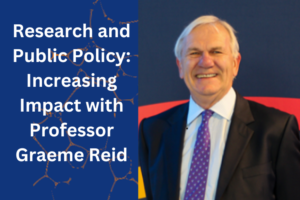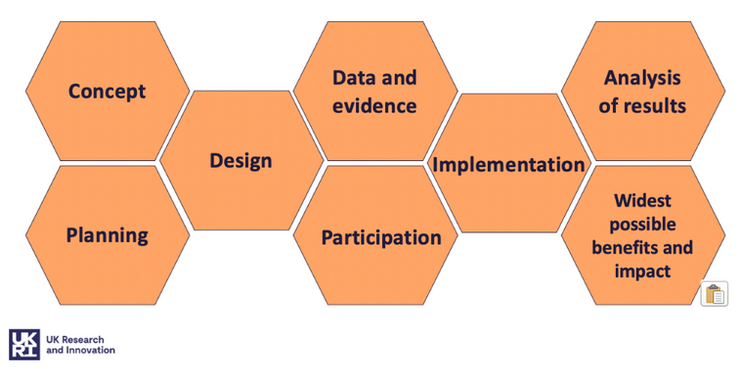
By Sara Shinton, Barry Smith, Helen Freeman and Katie Nicoll Baines
2023 has started with a strong policy theme with two events in our Research and Public Policy strand with Professor Graeme Reid (Research and Public Policy: Increasing Impact with Professor Graeme Reid ). This five-part series of events, taking place around the UK, gives researchers access to someone with a lifetime of experience in policy from multiple perspectives. We’ll be posting key messages from these events if you are unable to attend, whilst respecting the “Chatham House Rules” which prompted people to ask questions and seek guidance in confidence.
We’ve organised the insights from Graeme and his guests (starting with Dr Helen Cross from the Scottish Funding Council in Edinburgh and Dame Nicola Blackwood from Genomics England and the House of Lords in London) into three themes:
Orientation – advice to help fellows understand the process and eco system of policy making so they can prepare and engage to best effect
Relationships and Access – insights into the opportunities to meet and build visibility with those involved in policy
Messaging – strong lessons about effective communication to present your ideas in impactful ways
This first blog will focus on orientation and draws on messages from our first two events.
The title of this post came out of a discussion about one researcher’s experience of providing expertise and being surprised by how this happened and how meandering the path was leading to actual policy change. The message from Graeme was that “Policy is messy” and that expecting anything else will reduce your preparedness and set you up for frustration or confusion. Hence the need for a period of orientation so you understand (as much as is possible) how your voice and expertise fits into a confusing landscape. Only complex issues affecting diverse groups and interests require a policy discussion, so effective contributors consider ALL the views and interests.
This can be personally challenging as it will include engaging with groups or people with vastly different views including those whose positions might be considered emotional, sentimental or due to vested interest rather than logical and evidence-based. It’s important not to overlook these arguments as they will be heard by the policy makers and can be all the more compelling for their simplicity. Civil servants are guided in their work by neutrality so will not make value judgments or take sides – each contribution will be equally considered.
Researchers develop focussed mindsets which can impede their ability to see how an issue that sits with one policy area (we discussed minimal alcohol pricing as a health issue) will intersect with many others (for this example, those lobbying against it talked about impacts on industry, tourism and culture). Failing to understand and contextualise your points is a risk, particularly if you don’t craft your messages in an engaging way (more on this in the messaging blog). This is not to say that your arguments aren’t understood – underestimate civil servants at your peril! In Graeme’s experience they are at least as intellectually talented as researchers and are experts in constructing intellectually robust arguments for delivering on democratically decided actions.
A practical takeaway from the sessions so far, was to become familiar with other stakeholders’ perspectives and opinions so you can address these in your own communication with policy makers. Be honest with yourself about the barriers that others’ ideas might present to your own communication and resist the urge to dismiss views you’ve judged as inconsequential against your own “hierarchy” of validity. Graeme has seen ministers admit to using search engines for basic information about topics in their portfolios so this could be a useful tactic for broadening your own viewpoints (remembering that the algorithms search engines use will distort your own search results!)
There are several resources to help with policy orientation that explain the key players and processes in policy. We’re working on a Policy Toolkit to signpost Fellows to these resources, but for “entry level” understanding, the Government website includes an overview of How government works – GOV.UK (www.gov.uk) and a summary of the Policy Profession – GOV.UK (www.gov.uk). The Public Policy Design (blog.gov.uk) blog includes a range of articles and insights, including What does policymaking look like? – Public Policy Design (blog.gov.uk). Finally (with a reminder these are the 101s of policy) the UK Parliament website explains the roles of Parliament and the Government and has a summary page written for researchers on how to best engage with them. And if (like me) you need the real basics, there’s a guide called “Get Involved” which explains things in really simple terms and provides the search terms to help navigate Parliament’s website and structures.
After listening to Graeme my understanding was that Parliament confers powers on others, makes laws, scrutinises Government and is generally comfortable with ambiguity and unresolved questions. By contrast, Government is trying to “get stuff done” and can best achieve this when they have clarity about issues and clear solutions. They are highly accountable, so publish details of current and future interests with details of how to engage on Hansard, the official report of all Parliamentary debates.
Policy making processes will often include inquiries and current ones are listed on the UK Parliament website under “Find an Inquiry”. You may feel disappointed that current inquiries aren’t in synch with your own research interests and outputs but Graeme cautions that this virtually never happens. Instead, you need to view yourself in terms of your accumulated expertise and networks – you will have a valuable contribution to make even when it isn’t the exact contribution you hoped to make. A further cautionary note from Graeme is that you must never try to fit the questions being asked to the findings of your own research. Answer the questions and topic of the inquiry – the exam question – and be honest about any uncertainties associated with your knowledge. Policy makers are comfortable with ambiguity but look to arrive at a point of informed choice.
There’s clearly a craft in balancing these complex ideas whilst presenting something in a straightforward way. Graeme recommends that you learn this by finding a current inquiry or committee that matches your expertise and preparing an evidence submission. If you are unhappy with it you don’t have to submit, but you will have learnt something about the style and content expected. If this feels like too much of a first step there are many policy-related documents available to help understand how complex issues are presented to policy makers. These include the resources provided by the three UK Parliament research services:
POST – The Parliamentary Office of Science and Technology who publish POSTnotes, four page briefings reviewing emerging areas of research, and POSTbriefs, dynamic and strategic evidence syntheses that are produced rapidly in response to major developments in current affairs or select committee inquiries. POST are continually seeking contributions on expertise or literature, so take a look at their current work programme to see if you can get involved.
The House of Commons Library which provides an impartial research and information service for MPs and their staff, publishes their research and data dashboards.
The House of Lords Library which provides impartial research, reference and resources services to support Members and the work of the House of Lords.
If you feel more comfortable indirectly contributing to policy making processes, your professional institute may also provide an avenue for engagement. For example, the Institute of Physics Policy Centre provides an active and authoritative voice for physics.
For those ready to engage directly, we talked about some of the policy players you might encounter. There are analysts who work with neutrality and synthesise all views into succinct impartial reports. These people often have a statistical or legal background. These reports are considered by advisers who develop a view based on these reports and a range of expert views, presenting dispassionate recommendations. Also in the mix are lobbyists who represent (for a fee) ONE view or position and bring a deep knowledge about this position and its merits. Although they are experts in nuanced communication, they will be promoting one vantage point at the expense of others. Graeme mentioned that civil servants are extremely good at telling whether someone who presents themselves as an advisor is actually lobbying for their favoured outcome.
We also talked about the importance of all voices and experiences contributing to the evidence that affects policy (something explored in the Public Policy Design blog) and all our contributors so far have made clear they are always aware of the impacts of policy on people, hence the need for many different people to take up the opportunities to feed into consultations and framing.
Our next blog will follow the Salford event with Graeme and look at how to build relationships and networks in policy.

 Interdisciplinary research (IDR) runs through the UK’s research and innovation strategy, but close to a century after the
Interdisciplinary research (IDR) runs through the UK’s research and innovation strategy, but close to a century after the 